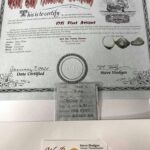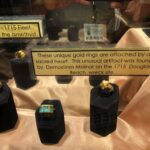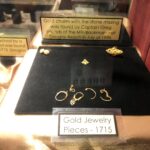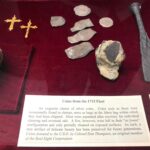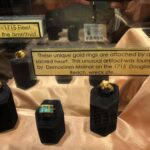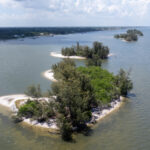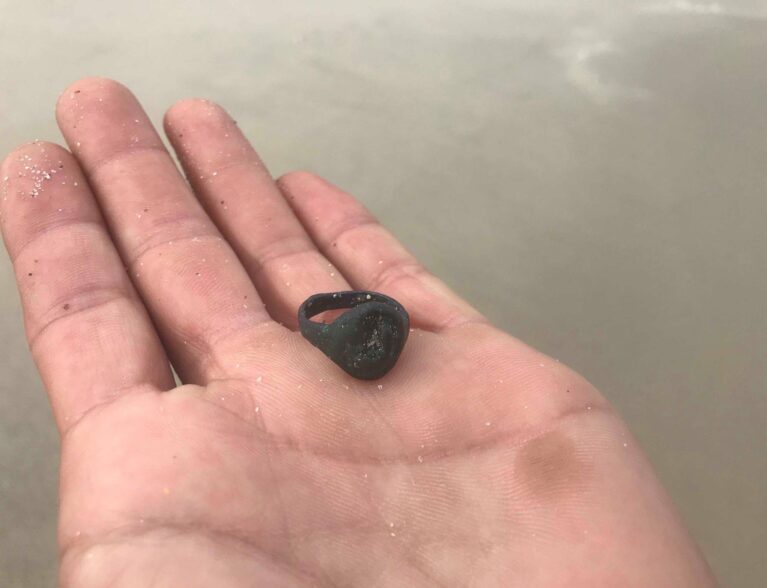
VERO BEACH — Just keep digging. Just keep digging.
Vero Beach resident Jeff Emlet tells himself that even when he searches for valuable items on the beach. He reasons that 95 percent of the findings will be junk such as aluminum cans and bottle tops. But, Emlet said he always digs anytime his metal detector vibrates.
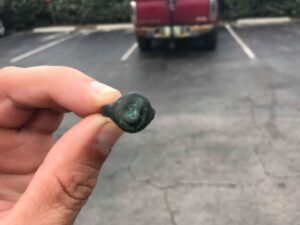
PHOTO PROVIDED BY JEFF EMLET
Over the years, Emlet’s tenacity led him to find necklaces and rings – crafted with gold and silver – along Indian River County shoreline. But, Emlet’s most interesting find came in December, when he located a ring buried about 10 inches deep in the sand near South Beach.
“I walked down the staircase, turned on the metal detector and found it in less than two minutes,” said Emlet, 37, Vero Beach. “Always dig. You never know what you’re going to dig up.”
Emlet said he took the ring to West Bay Trading Company, which specializes in examining shipwrecked treasure coins and artifacts. The Vero Beach company and an archaeologist examined the ring for five weeks.
Through extensive research, the archaeologist determined the tarnished silver ring came from the 1715 Spanish Fleet, a group of ships carrying four years worth of treasure. The storied ships sunk along different areas of Florida’s east coast, losing gold galleons and millions of dollars worth of jewelry beneath the waves.
Some of the hidden treasure has turned up along Indian River County beaches. West Bay Trading Company gave Emlet a certificate verifying his discovery.
Steve Hodges, owner and numismatist for West Bay Trading, said the ring is worth about $700. The item is the first silver ring from the 1715 Spanish Fleet to be certified at the company, Hodges said.
A shape in the form of a ‘J’ was embossed on the ring. Hodges said he thinks the shape once formed a full oval that had a stone inside.
“If there was a ruby or jewel inside, that would have been a heck of a score,”Emlet said.
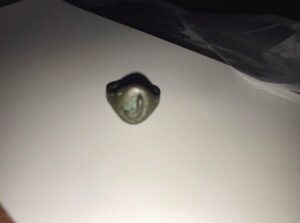
PHOTO PROVIDED BY JEFF EMLET
Emlet, who has been hunting for treasure for about two years, said the ring is the first artifact he found that possibly came from a sunken ship. The resident said he is working with other archaeological experts to get a second opinion on the ring’s value.
Emlet said he has found other interesting items buried in the sand including boat pieces from ships, bullet fragments and small parts from rocket boosters. The treasure hunter usually combs the beaches more than 20 times a month, spending at least two hours each time trying to find valuables.
Emlet usually starts his journey after 20 mph plus winds hit the area and after high tide.
“There’s stuff out there all the time,” Emlett said.
A piece of treasure
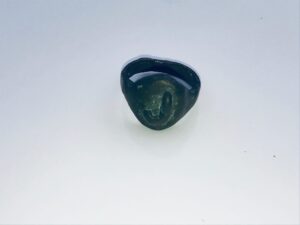
PHOTO PROVIDED BY JEFF EMLET
Emlet said he has no plans on selling his ring that is more than 300 years old. The ring, weighing 6.51 grams, is 77 percent silver and 23 percent copper, according to officials.
“It’s my first piece of treasure,” Emlet said. “I wouldn’t trade that for five to ten silver coins. It’s in really good condition.”
Emlet said he thinks the ring is worth more than a couple thousand dollars. The treasure hunter said he plans to take the ring to Mel Fisher’s Treasures in Sebastian and McLarty Treasure Museum in Vero Beach for examination.
Besides treasure, Emlet also found an artifact with a different historical significance on the beach during one of his searches.
In early January, Emlet was combing the sand with a metal detector near the 600 block of Reef Road in Vero Beach. Then, Emlet discovered an encrusted World War II-era land mine buried about 1-foot deep in the sand.
Another munition – also determined to be a land mine – washed ashore in the same area the same day, according to Indian River County deputies. Patrick Air Force Base explosive ordnance division responded to the scene and removed the munitions for disposal.
World War II-era munitions have been found throughout the years from Vero Beach down to Jensen Beach, including North and South Hutchinson Islands. The areas were known as the Fort Pierce Naval Amphibious Training Base, which the Navy used during World War II.
Other experts give opinions on ring
Mel Fisher’s Treasures and McLarty Museum both examine and collect shipwreck artifacts. Officials at the businesses said it would be difficult to confirm the silver ring came from the 1715 Spanish Fleet since it was found on the beach and not at the actual wreck site.
“As an archaeologist, it’s very difficult to get provenience without knowing the exact origin (of the item),” Florida Park Service Specialist Corey Kerkela said.
But, Kerkela, who works at McLarty Treasure Museum, said the encrustation on Emlet’s ring is a sign that the jewelry was once underwater. Kerkela said West Bay Trading’s certification that the ring is from the 1715 Spanish Fleet is most likely accurate.
“Silver will oxidize and turn black. Underwater it will grip onto other materials,” Kerkela said. “Nothing gets encrusted onto gold. It will come out looking the same way when it went it.”
1715 Fleet
A hurricane along Florida’s east coast sunk the 1715 fleet, made up of 11 Spanish ships and one French ship. The fleet was traveling from Havana, Cuba, to deliver treasure to Cadiz, Spain, where Philip V ruled as king.
The hurricane tore the ships apart like wooden toys, killing more than 1,000 people on board, according to the 1715 Fleet Society. The only ship not destroyed by the storm was the French warship ‘Griffon,’ which arrived in Brest, France, on August 31, 1715.
Back on Florida’s east coast, the beaches were covered with wreckage and bodies, the society said.
Society members said the only sunken ship in the fleet that has been accurately identified is the ‘Cabin Wreck,’ located about two miles south of the Sebastian Inlet. Treasure hunters named other ships in the wreck based on artifacts found, though the questionable identification has been repeated by writers and amateur historians, society members said.
Salvagers began recovering Spanish treasure off the coast in 1961. The discovery of the treasure from the lost fleet brought national and international attention to the area.
The wreckage site stretched from the southern Brevard County line to the northern Palm Beach County line. The area – now split into the counties Indian River, St. Lucie and Martin – became known as the ‘Treasure Coast.’
- Photo of silver ring certification (Provided by Jeff Emlet)
- Photo of gold jewelry from the 1715 Spanish Fleet inside Mel Fisher’s Treasure
- Photo of 1715 gold jewelry inside Mel Fisher’s Treasure
- Photo of silver coins from the 1715 Spanish Fleet inside McLarty Treasure Museum
- Gold jewelry items from the 1715 Spanish Fleet at Mel Fisher’s Treasure

